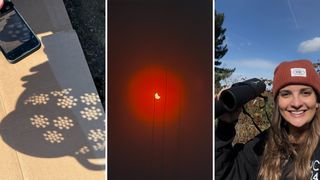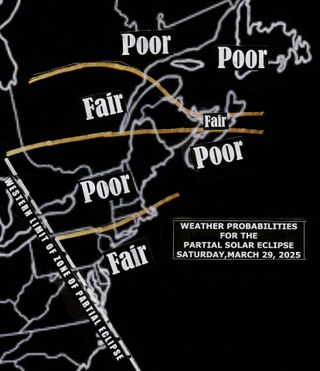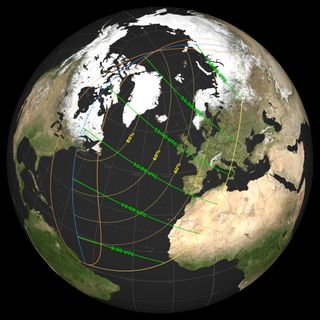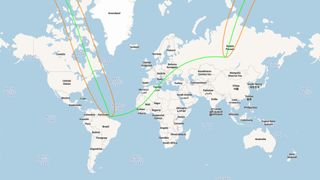This morning (March 29), during a partial solar eclipse, the moon bit off more than it could chew, taking a dramatic ‘bite’ out of the sun. From crisp crescent-shaped suns to the rare ‘devil’s horns’ and ‘double sunrise,’ March’s solar eclipse left skywatchers in awe — especially those in the right place at the right time. A partial solar eclipse occurs when the moon partially covers the sun, leaving a glowing crescent. Globally, the eclipse began at 4:50 a.m. EDT (0850 GMT), with the maximum eclipse peaking at 6:47 a.m.…
Read MoreTag: Stargazing
Solar eclipse US weather forecast: Best places to see the moon ‘bite’ the sun tomorrow
A partial solar eclipse is coming this weekend, but weather could be an issue for many hoping to get a glimpse of the moon “taking a bite” out of the sun. Skywatchers across much of New York State, New England and Atlantic Canada who are hoping to get a view of Saturday morning’s partial solar eclipse are unfortunately going to be at the mercy of a stationary weather system that will likely generate widespread cloudiness as well as a variety of precipitation ranging from rain, sleet and snow. The front…
Read MoreWhat will happen during the partial solar eclipse of March 2025?
What a difference a year makes! Just a year ago, countless millions across North America were anxiously awaiting the “great North American total eclipse of the sun” on April 8. Now, less than a year later, on Saturday, March 29, another eclipse of the sun will take place, but it’s quite likely that the prospective viewing audience will be considerably smaller. To produce this eclipse, the moon’s shadow falls chiefly on the north polar regions of Earth. Keep up to date with the latest solar eclipse news and events with…
Read MoreRare ‘solar horns’ will appear during partial solar eclipse on March 29 — Here are 6 of the best places in the US and Canada to see the unusual phenomenon
There’s something special about the partial solar eclipse on March 29, 2025. For North Americans in the right place at the right time — and who get clear skies — there’s a chance to see the unique spectacle of “solar horns,” a phenomenon where the cusps of an eclipsed crescent sun appear as two distinct points above the horizon during sunrise. For observers in the northeastern U.S. and eastern Canada aiming to witness this rare event, selecting the optimal location is crucial. Selecting a location for ‘solar horns’ “Solar horns”…
Read MoreWhat will the partial solar eclipse of March 2025 look like from space?
A partial solar eclipse will come to Earth on Saturday, March 29, 2025, as the moon passes in front of the sun. From Earth, photographers will capture images of a bite being taken out of the sun. From space, a fleet of satellites will image a shadow being cast across Earth. The moon projects two kinds of shadows at all times. There’s a large fuzzy outer shadow, called the penumbra, and a much smaller, darker central shadow, the umbra. The latter causes a total solar eclipse, which is seen across…
Read MoreAurora alert: Giant ‘hole’ in sun and strong geomagnetic storm converge to supercharge northern lights this weekend
A massive eruption on the sun that flung solar plasma toward Earth on Friday may trigger a strong geomagnetic storm this weekend that could supercharge auroras across the northern United States. The solar eruption, called a coronal mass ejection (or CME), exploded on Friday (March 21) even as a so-called “coronal hole” opened on the sun to unleash a separate high-speed stream of solar particles toward Earth. The result: A tag-team of solar material that should reach Earth this weekend to amplify northern lights displays late Saturday and early Sunday…
Read MoreDark skies and epic Winter Star Party — why the Florida Keys are more than just a Spring Break destination
If you’re looking for the best locations for astrophotography and skywatching, look no further than the Florida Keys. A 125-mile string of tropical coral islands linked by bridges that stretches into the shallow waters of the Florida Straits and the Gulf of Mexico, it’s home to fishing, boating and snorkeling, but also stargazing. Related: Night sky for tonight: Visible planets, stars and more in this evening’s sky As well as some of the darkest skies on the U.S. East Coast, it’s also the nation’s southernmost point. At 24.5 degrees north,…
Read MoreThe MacBook Pro is one of the best laptops for astronomers and it’s just hit its lowest-ever price
The MacBook Pro is one of the best laptops for astronomers, delivering processing power, portability, and incredible display quality. For professional and amateur stargazers it’s an invaluable asset offering some of the best-in-class image processing, data analysis, and telescope control. Save $200 and buy the Apple MacBook Pro 14-inch for just $1,399 at Amazon. Regardless of the model, the MacBook Pro is always in demand but it comes with a hefty price tag. If you’re looking to upgrade your current laptop or a Mac is on your wishlist, then this…
Read MoreWhere will the partial solar eclipse be visible in March 2025?
Although it won’t be as spectacular as North America’s April 2024 total solar eclipse, the first solar eclipse since the “ring of fire” eclipse in October 2024 is set to bring stunning views to some lucky eclipse chasers. Just two weeks after a stunning total lunar eclipse on March 13-14, 2025, skywatchers across the western Northern Hemisphere will see at least a partial solar eclipse on March 29, 2025. For some observers, an eclipsed sun will appear on the eastern horizon at sunrise — if skies are clear — as…
Read MoreThere’s a total lunar eclipse coming. How will these 2 solar-powered moon probes survive the darkness?
When the moon falls into Earth’s shadow Thursday night into Friday (March 13-14), observers will be treated to views of a “blood moon” total lunar eclipse. But given that lunar spacecraft are solar-powered, how do they survive when they’re cut off from the sun? For NASA’s Lunar Reconnaissance Orbiter (LRO), which has been orbiting the moon since 2009, it will be time to batten down the hatches. “LRO’s science instruments and some components not needed by the spacecraft will be powered off during the total lunar eclipse,” Noah Petro, project…
Read More








